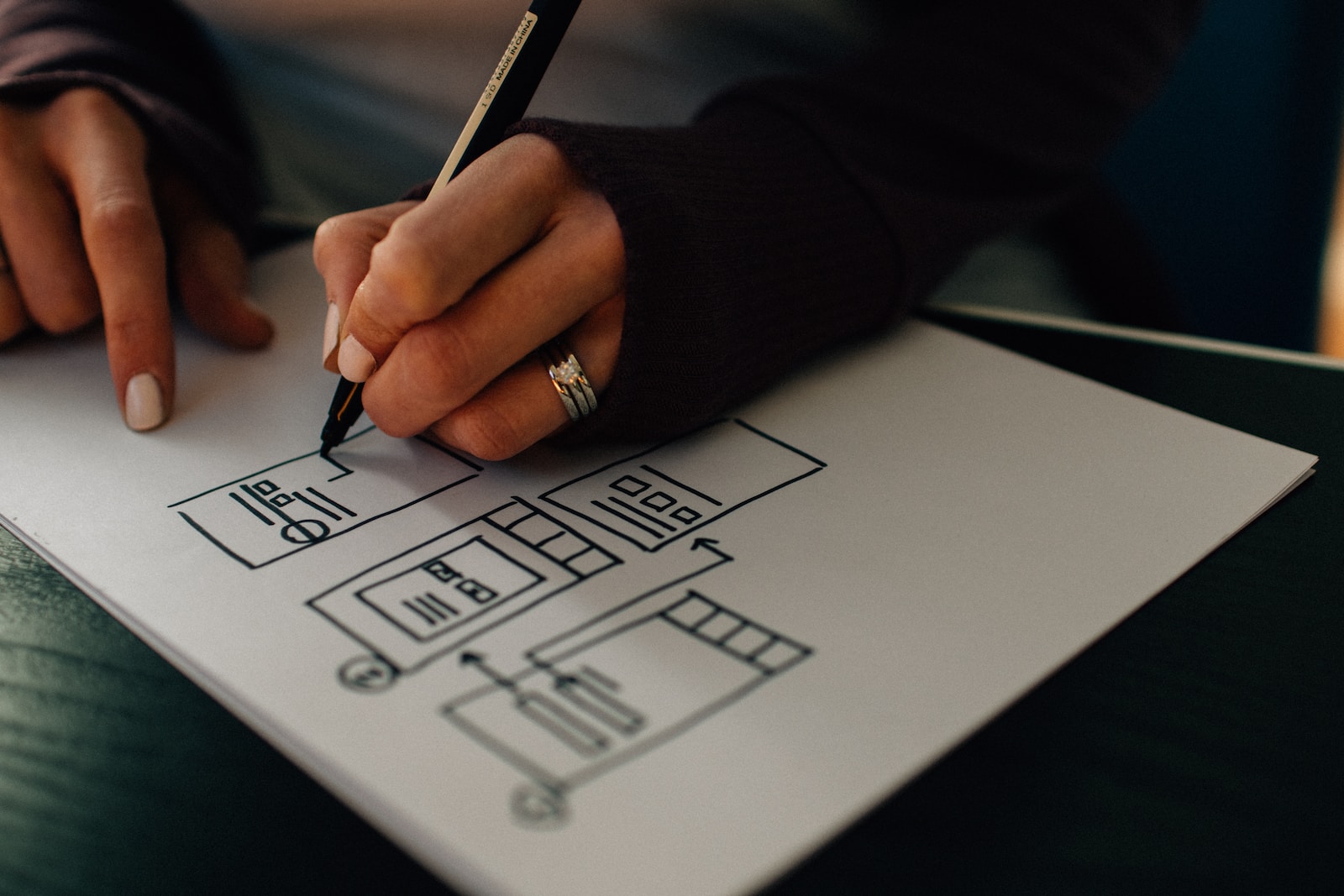In the world of design, user interface (UI) and user experience (UX) are two important concepts that are often used interchangeably. However, they have distinct differences and play different roles in creating successful digital products.
UI refers to the visual elements that users interact with, such as screens, buttons, and icons. It focuses on the aesthetics and usability of the product, aiming to create visually appealing and user-friendly interfaces. On the other hand, UX encompasses the entire experience a user has with a product, including how they feel about the interaction. It is concerned with the overall user journey and satisfaction.
While UI focuses on the visual aspects, UX takes a holistic approach to the entire user experience. These two aspects often work together to create products that are both aesthetically pleasing and provide a seamless and satisfying user experience.
Key Takeaways:
- UI refers to the visual elements that users interact with, while UX encompasses the entire user experience.
- UI focuses on aesthetics and usability, while UX focuses on the overall user journey and satisfaction.
- Both UI and UX are crucial in creating successful digital products.
- UI designers focus on the visual elements and interactions, while UX designers ensure a seamless user experience.
- Good UI and UX design enhance engagement, usability, and user satisfaction.
Roles and Responsibilities of UI and UX Designers
UI and UX designers are essential contributors to the success of digital products. While their roles may overlap at times, they each bring unique skills and responsibilities to the table.
The Importance of UI Design
UI designers focus on the visual elements of a product, creating visually appealing and user-friendly interfaces. They are responsible for organizing page layouts, selecting color palettes and fonts, and designing interactive elements. Their goal is to make the user interface visually engaging and intuitive, guiding users through the product seamlessly. By prioritizing aesthetics, UI designers enhance the overall user experience and draw users in.
The Importance of UX Design
UX designers, on the other hand, take a holistic approach to product design, focusing on the entire user experience. They conduct user research, develop user personas, and create user journey maps to understand user needs and pain points. Based on their findings, UX designers build wireframes and prototypes, and perform user testing to iterate and improve the product. By prioritizing usability and user satisfaction, they ensure that the product meets the needs and expectations of its users.
The Collaboration Between UI and UX Designers
Although UI and UX designers have different responsibilities, their collaboration is crucial for creating a seamless and satisfying user experience. They work closely together, leveraging their respective expertise to create digital products that are visually appealing, user-friendly, and functional. By collaborating with stakeholders, developers, and each other, they ensure that the product meets both the visual and experiential needs of its users.
In conclusion, UI and UX designers play vital roles in the development of digital products. UI designers focus on the visual elements and interactions, while UX designers prioritize the overall user experience. By working together and harnessing their unique skills and responsibilities, they create products that are visually appealing, user-friendly, and provide a positive user experience.
Differences Between UI and UX Design
When it comes to designing digital products, it’s essential to understand the key differences between user interface (UI) and user experience (UX) design. While both of these disciplines are closely related, they have distinct focuses and responsibilities.
UI design primarily deals with the visual aspects of a product, such as the layout, colors, and typography. It aims to create visually engaging and user-friendly interfaces that are both aesthetically pleasing and functional. UI designers pay close attention to the organization and structure of a product’s interface, ensuring that it is intuitive and easy to navigate.
On the other hand, UX design takes a more holistic approach by considering the entire user journey and experience. UX designers focus on understanding the needs and desires of the users and strive to create products that are not only usable but also enjoyable to interact with. They conduct extensive user research, develop user personas, and create user journey maps to ensure that every touchpoint in the user’s interaction with the product is seamless and satisfying.
To better illustrate the key differences, let’s take a look at the following table:
| UI Design | UX Design |
|---|---|
| Visual elements | Overall user experience |
| Focuses on aesthetics | Focuses on usability and emotional connection |
| Deals with individual elements | Takes a holistic approach |
As you can see, UI and UX design have their own distinct roles and responsibilities. UI design focuses on creating visually appealing interfaces, while UX design ensures a seamless and satisfying user experience. By understanding and harnessing the power of both disciplines, designers can create products that are not only visually stunning but also provide a positive overall user experience.
The Importance of UI and UX Design
Good UI and UX design are essential for creating successful digital products. They have a significant impact on website usability and offer a range of benefits for both users and businesses. Let’s explore some of the key advantages of implementing good UI and UX design practices.
Enhanced User Satisfaction
One of the primary benefits of good UI and UX design is increased user satisfaction. When users have a positive experience interacting with a product, they are more likely to enjoy using it and continue using it in the future. Well-designed interfaces that are intuitive, visually appealing, and easy to navigate contribute to a positive user experience.
By considering user needs and expectations, UI and UX designers can create interfaces that are user-friendly and address the pain points of the target audience. They ensure that users can easily find what they are looking for, complete desired actions, and navigate through the product without confusion. This leads to a higher level of user satisfaction, which ultimately helps build customer loyalty and drive business growth.
Improved Website Usability
UI and UX design also play a crucial role in optimizing website usability. A well-designed UI ensures that users can easily interact with the product and find the information they need. It involves organizing page layouts, choosing appropriate color schemes and fonts, and designing intuitive navigation structures.
UX design, on the other hand, focuses on the overall user journey and ensures that the product is accessible, responsive, and meets the needs of the target audience. UX designers conduct user research, create user personas, and develop user journey maps to understand user behavior and design products that align with user expectations.
By investing in good UI and UX design, businesses can enhance website usability, reduce user frustration, and increase conversion rates. A user-friendly interface encourages users to explore the product, engage with its features, and complete desired actions, leading to a positive user experience and improved business outcomes.
Positive Brand Perception
UI and UX design directly impact how users perceive a brand. A well-designed product that offers a seamless and enjoyable user experience reflects positively on the brand and enhances its reputation. When users have a positive interaction with a product, it creates a sense of trust and credibility.
Additionally, a visually appealing interface with a consistent and cohesive design language helps establish a strong brand identity. By incorporating branding elements, such as logos, colors, and typography, into the UI design, businesses can create a cohesive brand experience that resonates with users.
In summary, good UI and UX design contribute to user satisfaction, improved website usability, and positive brand perception. By investing in these design practices, businesses can create engaging digital products that provide a seamless and satisfying user experience, ultimately driving success and growth.
Conclusion
In conclusion, understanding the difference between user interface (UI) and user experience (UX) design is crucial for creating successful digital products. While UI focuses on the visual elements, UX encompasses the overall user journey and satisfaction. Both UI and UX designers play important roles in the development process, collaborating with stakeholders and developers to ensure a seamless user experience.
To be effective in UI and UX design, it is essential to keep up with the latest design trends and conduct user research. By understanding user needs and preferences, designers can create visually appealing and user-friendly interfaces. Collaborating with stakeholders is also key to ensure that the design aligns with the project goals and objectives.
Continuous iteration and improvement are vital in UI and UX design. By gathering and incorporating user feedback, designers can refine the product to meet user expectations and enhance usability. This iterative process allows for the creation of digital products that are engaging, intuitive, and provide a positive overall experience.
In summary, effective UI and UX design lead to numerous benefits, including enhanced visual appeal, improved website usability, increased user satisfaction, and customer loyalty. By considering both UI and UX design principles, designers can create products that are visually appealing, user-friendly, and provide a positive overall user experience.
FAQ
What is the difference between user interface and user experience design?
User interface (UI) design refers to the visual elements of a product that users interact with, such as screens, buttons, and icons. User experience (UX) design, on the other hand, encompasses the overall experience a user has with a product, including how they feel about the interaction.
What are the roles and responsibilities of UI and UX designers?
UI designers focus on the visual elements and interactions, creating visually appealing interfaces. UX designers ensure a seamless and satisfying user experience, conducting user research, developing personas, creating wireframes, and performing user testing.
What are the key differences between UI and UX design?
UI design focuses on the visual look and feel of a product, while UX design is concerned with the overall user experience, including usability, accessibility, and emotional connection. UI design is more focused on individual elements and interactions, while UX design takes a holistic approach to the entire user journey.
What is the importance of UI and UX design?
Good UI design enhances the visual appeal and usability of a product, while good UX design ensures a positive and satisfying user experience. Both contribute to increased user satisfaction, repeat usage, and customer loyalty.
What are some tips for effective UI and UX design?
To be effective in UI and UX design, it is important to stay updated with design trends, conduct user research, collaborate with stakeholders, and continuously iterate and improve the design based on user feedback.

